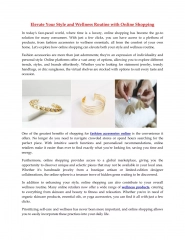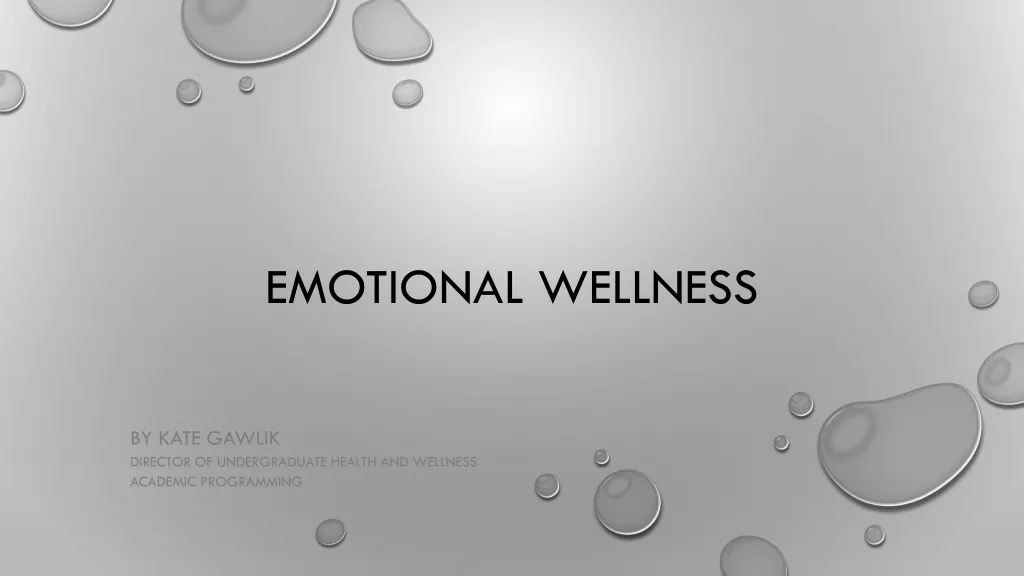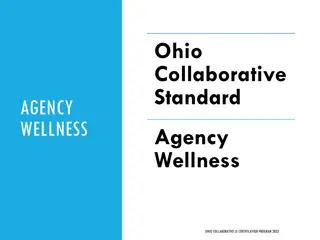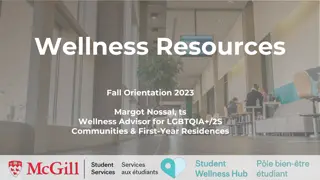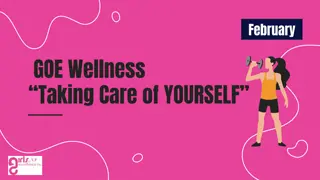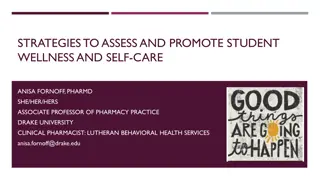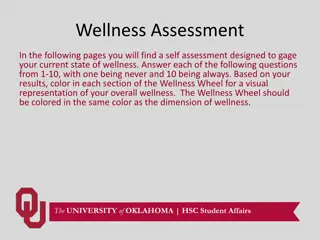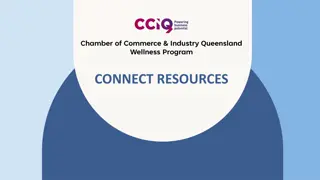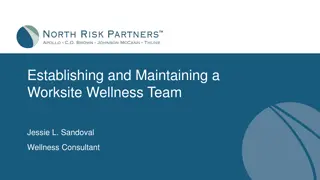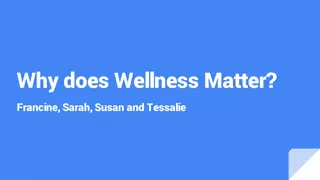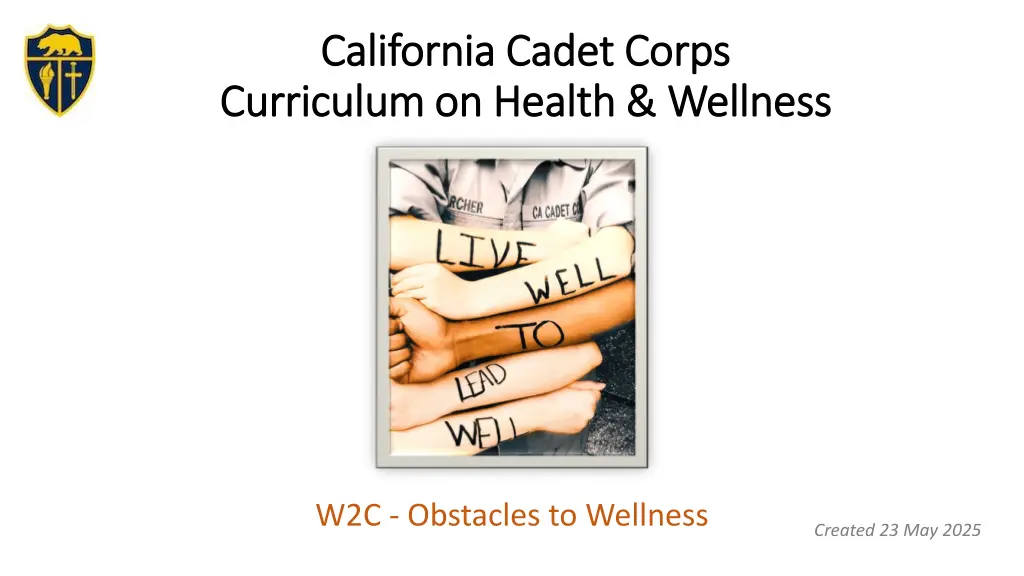
Cadet Corps Wellness Curriculum: Overcoming Obstacles
Explore the California Cadet Corps curriculum on health and wellness, focusing on identifying and overcoming obstacles to wellness. Topics include stress, sedentary lifestyle, malnourishment, depression, and more. Unit leaders are empowered to educate and lead their peers in addressing these challenges effectively.
Download Presentation

Please find below an Image/Link to download the presentation.
The content on the website is provided AS IS for your information and personal use only. It may not be sold, licensed, or shared on other websites without obtaining consent from the author. If you encounter any issues during the download, it is possible that the publisher has removed the file from their server.
You are allowed to download the files provided on this website for personal or commercial use, subject to the condition that they are used lawfully. All files are the property of their respective owners.
The content on the website is provided AS IS for your information and personal use only. It may not be sold, licensed, or shared on other websites without obtaining consent from the author.
E N D
Presentation Transcript
California Cadet Corps California Cadet Corps Curriculum on Health & Wellness Curriculum on Health & Wellness W2C - Obstacles to Wellness Created 23 May 2025
Obstacles to Wellness Obstacles to Wellness Agenda Agenda C1. Stress C2. Sedentary Lifestyle C3. Malnourishment C4. Depression/Suicide C5. Sleep Deprivation C6. Violence & Anger Management C7. Bullying C8. Tobacco / Nicotine (smoking / vaping / chewing) C9. Underage Drinking & Binge Drinking C10. Abusing Drugs C11. Sexually Transmitted Diseases C12. Sexual Orientation C13. Blended Families 2
Objectives, 1 of 2 Objectives, 1 of 2 DESIRED OUTCOME (Leadership) Unit leaders can identify obstacles to wellness in their cadet peers and subordinates. They will also be able to influence, educate, and lead their fellow cadets by steering them to tools and resources for overcoming these obstacles. 1. Given a scenario about a cadet that shows stress signs, cadets can identify the symptoms of stress and recommend some appropriate behavior modification strategies. 2. Given a scenario about a cadet that shows signs of a sedentary lifestyle, cadets can correctly identify the symptoms and recommend some appropriate behavior modification strategies. 3. Given a scenario about a cadet that shows signs of malnourishment, cadets can correctly identify the symptoms and recommend some appropriate behavior modification strategies. 4. Given a scenario about a cadet that shows signs of depression and/or suicide, cadets can correctly identify the symptoms and recommend some appropriate behavior modification strategies. 5. Given a scenario about a cadet that shows signs of sleep deprivation, cadets can correctly identify the symptoms and recommend some appropriate behavior modification strategies. 6. Given a scenario about a cadet that shows signs of violence or lack of anger management, cadets can correctly identify the symptoms and recommend some appropriate behavior modification strategies. 3
Objectives, 2 of 2 Objectives, 2 of 2 7. Given a scenario about a cadet that shows signs of being bullied or cyberbullied, cadets can correctly identify the symptoms and recommend some appropriate behavior modification strategies. 8. Given a scenario about a cadet that shows signs of tobacco use or vaping, cadets can correctly identify the symptoms and recommend some appropriate behavior modification strategies. 9. Given a scenario about a cadet that shows signs of alcohol abuse, cadets can correctly identify the symptoms and recommend some appropriate behavior modification strategies. 10.Given a scenario about a cadet that shows signs of drug abuse, cadets can correctly identify the symptoms and recommend some appropriate behavior modification strategies. 11.Given a scenario about a cadet that shows signs of irresponsible sexual practices or sexually transmitted infection/disease, cadets can correctly identify the symptoms and recommend some appropriate behavior modification strategies. 12.Given a scenario about a cadet that shows signs of being bullied, harassed/assaulted, or discriminated against or depression due to their gender identity or sexual orientation, cadets can correctly identify the symptoms and recommend some appropriate support strategies. 13.Given a scenario about a cadet that shows signs of becoming part of a blended family following the divorce or death of a parent, cadets can correctly identify the symptoms and recommend some appropriate support strategies. 4
C1. Stress C1. Stress Signs Signs Stress symptoms can affect one s body, thoughts, feelings, and behavior Recognizing symptoms helps manage them Stress left unchecked can contribute to many health problems Physical effects on the body Headache Muscle tension or pain Fatigue Stomachache Sleep problems Effects on behavior Overeating / undereating Angry outbursts Drug or alcohol abuse Tobacco use Social withdrawal Exercising less often Poor school performance Panic attacks Rebellion Effects on mood Anxiety Restlessness Lack of motivation or focus Feeling overwhelmed Irritability or anger Sadness or depression Disillusionment 5
Strategies for Stress Relief Strategies for Stress Relief (Master Class, 2021) (Master Class, 2021) * See additional information and videos about these practices in Lesson W2B. Practice meditation: when you give your mind something to focus on other than the stressor, you can help create space between yourself and the stressful situation Get some exercise: releases endorphins producing a feel-good effect Try yoga or Tai chi: proven to be beneficial to those who experience chronic stress Take deep breaths: helps refocus your mind and physically calm down your body Get better sleep:Improving your sleep hygiene can make it easier to fall asleep and stay asleep at night Practice positive self-talk: Sometimes your internal monologue contributes to your stress levels; try altering your perception when you respond to a particular stressor Avoid triggers: everyone s are different, but it s important to impose distance between you and triggers (like social media, the news, or a particular person) For signs of stress, review sections B1-B11, B14, and B16 If symptoms/feelings continue, seek professional help; school guidance counselors are a good start 6
C2. Sedentary Lifestyle C2. Sedentary Lifestyle Signs Signs Risks of a Sedentary Lifestyle Physical inactivity may increase the risks of certain cancers. Physical inactivity may contribute to anxiety and depression. Physical inactivity has been shown to be a risk factor for certain cardiovascular diseases. People who engage in more physical activity are less likely to develop coronary heart disease. People who are more active are less likely to be overweight or obese. Sitting too much may cause a decrease in skeletal muscle mass. Physical inactivity is linked to high blood pressure and elevated cholesterol levels. Symptoms of Sitting Disease Abdominal obesity Easily out of breath Lack of muscle tone Significant daily screen time (TV, video games, computer, social media more than 2 hours/day) Failing physical fitness tests Lack of participation in sports or other competitive activities Behavioral concerns (depression, stress, anxiety) 7
Strategies for a Sedentary Lifestyle Strategies for a Sedentary Lifestyle (Linda Trinh, Dori Rosenberg, & Allyson Tabaczynski, Retrieved 2025) Use a fitness tracker or journal to monitor your sitting time Consider combining chores with seated tasks such as folding clothes while watching television Stand up during commercial breaks while watching television or get up to change the channel Walk instead of riding Stand up to text, read, do homework at a stand-up desk, stand while on public transportation Do micro-workouts throughout the day Schedule a walk or exercise in your day rather than wait to see where it will fit in Pace while talking on the phone Only watch television when it s dark outside Take the stairs instead of an elevator/escalator if you can Park farther away from your destination to increase the distance you need to walk Be creative when thinking about your day to find ways you can move more and sit less 8
C3. Malnourishment C3. Malnourishment Signs Signs Many teens eat fast-food or processed-food diets that are high in sugar, fat, and sodium, and lack calcium, fiber and iron. oThis can lead to being overweight or obese, as well as health problems Sugar Epidemic: The American Academy of Pediatrics (AAP) recommends those 2-18 years of age have a maximum of 6 teaspoons, or 25 grams of added sugar, per day. (Korioth, 2019) oThis group takes in more than 3 times this amount on average Iron deficiencies cause cadets (especially female) to be sluggish, tired, weak, to have slower cognitive development, decreased immune function, and show decreased performance at school. Calcium deficiencies cause cadets to have weak bones and be more prone to fractures. Fiber deficiencies can cause constipation and other subsequent health problems 9
Eating Disorders Eating Disorders Bulimia Nervosa An eating disorder characterized by binge eating followed by purging. Symptoms Binges on huge quantities of high-caloric foods Purges by self-induced vomiting or by using laxatives Binges may alternate with severe diets Dramatic weight fluctuations Long periods of time in the bathroom (may attempt to hide purges with running water) Anorexia Nervosa a serious disorder in eating behavior that is characterized especially by a pathological fear of weight gain leading to faulty eating patterns, malnutrition, and usually excessive weight loss. It occurs most commonly in young women in their teens and early twenties. (Merriam-Webster, Retrieved 2025) Symptoms A perfectionist / high achiever in school Female (typically, but not always) Suffers from low self-esteem Starvation / not eating 10
Strategies for Eating Healthy Strategies for Eating Healthy Keep a food journal or find an app to track what you eat Track sugar, calcium, iron, fiber (and calories if over/underweight) Choose a healthy plate for each meal; protein, healthy grains/starch, non-starchy vegetables Eat a rainbow variety of fruits and vegetables Learn whether you are over- or underweight and establish a daily calorie threshold Reduce sugar; avoid high-sugar drinks replace sodas with water Avoid highly processed foods Read labels of the foods you buy learn what s good for you and what s not 11
C4. Depression / Suicide C4. Depression / Suicide Signs Signs Issues such as peer pressure, academic expectations, and changing bodies can bring a lot of ups and downs for teens. But for some teens, the lows are more than just temporary feelings they are a symptom of depression. (Mayo Clinic, 2022) Watch for emotional changes Feelings of sadness, which can include crying spells for no apparent reason Frustration or feelings of anger, even over small matters Feeling hopeless or empty Irritable or annoyed mood Loss of interest or pleasure in usual activities Loss of interest in, or conflict with, family and friends Low self-esteem Feelings of worthlessness or guilt Fixation on past failures or exaggerated self- blame or self-criticism Extreme sensitivity to rejection or failure, and the need for excessive reassurance Trouble thinking, concentrating, making decisions and remembering things Ongoing sense that life and the future are grim and bleak Frequent thoughts of death, dying or suicide 12
Depression Signs, Cont. Depression Signs, Cont. Behavioral changes Frequent complaints of unexplained body aches and headaches, which may include frequent visits to the school nurse Social isolation Poor school performance or frequent absences from school Less attention to personal hygiene or appearance Angry outbursts, disruptive or risky behavior, or other acting-out behaviors Self-harm; examples are cutting or burning Making a suicide plan or a suicide attempt Watch for changes in behavior, such as: Tiredness and loss of energy Insomnia or sleeping too much Changes in appetite decreased appetite and weight loss, or increased cravings for food and weight gain Use of alcohol or drugs Agitation or restlessness for example, pacing, hand-wringing, or an inability to sit still Slowed thinking, speaking, or body movements 13
Suicide Warning Signs/Suicidal Thoughts Suicide Warning Signs/Suicidal Thoughts (Mayo Clinic, 2022) (Mayo Clinic, 2022) Talking about suicide for example, making statements such as "I'm going to kill myself," "I wish I were dead," or "I wish I hadn't been born" Getting the means to take your own life, such as buying a gun or stockpiling pills Withdrawing from social contact and wanting to be left alone Having mood swings, such as being emotionally high one day and deeply discouraged the next Being preoccupied with death, dying, or violence Feeling trapped or hopeless about a situation Increasing use of alcohol or drugs Changing normal routine, including eating or sleeping patterns Doing risky or self-destructive things, such as using drugs or driving recklessly Giving away belongings or getting affairs in order when there's no other logical explanation for doing this Saying goodbye to people as if they won't be seen again Developing personality changes or being severely anxious or agitated, particularly when experiencing some of the warning signs listed above 14
Potential Suicide Triggers Potential Suicide Triggers Death of a parent Divorce of parents Feeling like a "pawn" that is being used between feuding, divorced parents Joining a new family with a step-parent and step-siblings Breaking up with a boyfriend / girlfriend Moving to a new community Not feeling accepted by peers Being ridiculed by classmates Feeling misunderstood Any experience perceived to be "humiliating" Alcohol abuse (binge drinking) Drug abuse Being bullied by classmates Warning signs aren't always obvious, and they may vary from person to person. Some people make their intentions clear, while others keep suicidal thoughts and feelings secret. 15
Strategies for Depression/Suicide Strategies for Depression/Suicide Talk/listen to him/her, focus on what they are saying (don t minimalize his/her experience) Seek/help to seek a medical professional if you or your cadet experience depression, confused thinking, or destructive emotions, thoughts, or behaviors Watch for signs of suicide, alcohol, or drug abuse act immediately if signs are present Engage in an exercise routine (releases feel-good endorphins): walk in nature, jog, dance, etc. Meditate Find healthy things you enjoy doing to take your mind off what s bothering you; start with 5 minutes and increase time each day Express yourself through creativity write, paint, draw, sing/write a song, dance, play an instrument find what brings you relief, and possibly even joy 16
SUICIDE STRATEGY SUICIDE STRATEGY Do not take any chances if a fellow/subordinate cadet shows signs of suicide. Immediately talk to an adult about it or call: 1-800-273-8255 Hotline for Suicide Prevention Ensure someone is at his/her side until help has arrived!!! 17
C5. Sleep Deprivation C5. Sleep Deprivation Signs & Strategies Signs & Strategies Sleep deprivationis bad for your mental and physical health Strategies for Sleep Deprivation Establish a regular sleep and wake schedule Have a bedtime routine o Drink decaffeinated tea o Take a bath o Do 15 minutes of yoga o Read a book (a non-violent/action story) Create an optimal sleep environment (dark and cool) Stop watching the clock Unplug o Tech-free zone o No screens o No video games o No internet activity Signs of Sleep Deprivation Irritability Sleeping longer on weekends than weekdays Difficulty concentrating Panic attacks Negativity Impulsive behavior Attending zero period (class held prior to first period classes) Video game bingeing Dozing in class Relationship problems (it s difficult to have a good relationship with a grumpy zombie) 18
C6. Violence & Anger Management C6. Violence & Anger Management Signs Signs Signs of Anger Management Problems can t control aggressive impulses, hits people or gets into physical fights frequent explosive outbursts is reflexively oppositional, argues heatedly, and seldom gets to resolution is unable to engage in constructive problem-solving and does not acknowledge his/her role in creating the situation, instead feeling constantly victimized or picked on frequently loses friends, alienates adults, or is otherwise embroiled in interpersonal conflict seems preoccupied with revenge or getting back at someone damages property repeatedly expresses hatred toward self or someone else can t get over a past situation or occurrence wants to hurt someone else or themselves (or actually do so) 19
Strategies for Anger Management Strategies for Anger Management Activities for When Feeling Angry Participate in physical activities Get it out hit a punching bag, a pillow repeatedly, or use a foam padded bat Take a time-out or time-in Get into music Identify triggers to anger journal/write down Creatively express angry feelings Develop healthy and meaningful connections with a parent or guardian Form well-developed social skills Get sufficient sleep Talk about how you are feeling with someone you trust Strategies for In the Moment Control your breathing (deep breathing) Relax your muscles Write down what made you angry Later, put it in context (displacement) 20
C7. Bullying C7. Bullying Signs Signs Bullying is unwanted, aggressive behavior among school-aged children that involves a real or perceived power imbalance. The behavior is repeated, or has the potential to be repeated, over time. Effects of Bullying Kids who are bullied can be made to feel like they are: o different o powerless Kids who are bullied have a hard time standing up for themselves. They think the kid who bullies them is more powerful than they are. Being bullied can make them: o sad, lonely, or nervous o feel sick o have problems at school o bully other kids Signs of bullying: making threats spreading rumors attacking someone physically or verbally excluding someone from a group on purpose o unpopular o alone 21
Cyberbullying/Signs Cyberbullying/Signs bullying that takes place using electronics cell phones/computers/tablets uses social media sites, text messages, chat, and websites can be text messages or emails, rumors sent by email, or posted on social networking sites, and embarrassing pictures, videos, websites, or fake profiles Some cyberbullying crosses the line into unlawful or criminal behavior Can be worse than traditional bullying Signs/Effects of Cyberbullying Cadets who are cyberbullied are more likely to: use alcohol and drugs skip school experience in-person bullying receive poor grades have lower self-esteem have more health problems Cyberbullying Statistics (Vojinovoc, 2024) 59% of U.S. teenagers have experienced online bullying/harassment 15% of young cyberbullying victims prefer to keep it a secret Students are almost twice as likely to attempt suicide if they have been cyberbullied 80% of teens say others cyberbully because they think it is funny 37% of bullying victims develop social anxiety 22
Strategies for Bullying & Cyberbullying Strategies for Bullying & Cyberbullying All cadets should report bullying to adults to stop (possible life at stake) Report immediately to school guidance counselors, commandants, or a trusted teacher, especially if the bully is at school Cadets should respond quickly and consistently to bullying behavior and send the message it s NOT acceptable For those being bullied: Bullying is common (1/3 of all students are bullied) This isn t your fault (remember how great you are) Build your army (surround yourself with those who care about you) Tactics include: ignore the bullies, avoid them when possible, travel in packs, find a way out Find someone you can talk to (teacher, guidance counselor, parent, friend) In addition, for those being cyberbullied: 4-step process: Tighten up all your security settings (privacy is prevention) Don t respond or retaliate (pours gas on the fire) Block the bully if possible (where only those in your contacts can contact/reach you) Save the information and report it to someone (cyberbullying is prohibited on most social media sites and is illegal in several states) 23
C8. Tobacco / Nicotine C8. Tobacco / Nicotine (smoking, vaping, chewing) (smoking, vaping, chewing) Signs Signs Signs of tobacco use Persistent cough Stained teeth Stale, smoky odor (especially skin, hair, mouth, fingers, and clothes) Decreased endurance (increased blood pressure and pulse rate) Increased spending (it s expensive) Signs a person is vaping Unfamiliar device: can look like a pen/USB flash drive Drinking more water:vaping causes dehydration/dry mouth Nosebleeds:dehydratingchemicals reduce moisture in nose Smoker's cough Mouth sores: mouth sores that won't heal (vapors upset the immune system) New batteries/chargers:Most devices require a charge Discarded vaping pods and devices: discarded cotton balls, thin metallic oils, pods or atomizers A sweet scent in the air:sweet flavors are now banned, but older vapes leave a lingering scent 24
Strategies to Quit Nicotine Strategies to Quit Nicotine (WebMD, Retrieved 2025) (WebMD, Retrieved 2025) Find your reason for quitting; choose a reason that s strong enough to outweigh your urge write it down Prepare before going 'cold turkey'; line up support in advance. Ask your doctor about all the methods that can help, such as quit-smoking classes, apps, counseling, medication, and hypnosis. Consider temporary nicotine replacement therapy (patches, lozenges, gum) Lean on your loved ones ask for their support Discover healthy alternatives that help you relax Avoid alcohol and other triggers Get rid of cigarettes and smoking-related items Wash clothes and anything that smells of tobacco smoke Know what symptoms to expect during nicotine withdrawal Exercise more Find distractions to cope with cravings Change your routine, i.e., go for a walk after meals All forms of tobacco are harmful and addictive. There is NO safe tobacco product. Never trying them is the best form of prevention. 25
C9. Underage Drinking & Binge Drinking C9. Underage Drinking & Binge Drinking Signs Signs Signs of Teenage Drinking Note: Cadets may drink alcohol because they feel peer pressure to drink, want to try something risky, new, or forbidden, or because they feel stressed. If you observe your fellow or subordinate cadets participating in underage drinking especially bingeing, or participate yourself, it becomes critical to prevent injury, death, damage, or legal trouble by not drinking and driving or allowing other cadets to do so. Changes in mood, including anger/irritability Academic and/or behavioral problems in school Rebelliousness Changing groups of friends Low energy level Less interest in activities and/or care in appearance Smelling alcohol on the breath Problems concentrating and/or remembering Slurred speech Coordination problems Hiding whereabouts 26
Strategies for Alcohol Consumption Strategies for Alcohol Consumption (Cleveland Clinic, 2023) (Cleveland Clinic, 2023) Understand your relationship with alcohol Set a date to quit and stick to it Be aware of your triggers Find community and support Consider professional help Engage in other activities Remove alcohol from your home Practice self-care Have a planned response when asked to drink, such as I don t drink, or I have a medical condition Don t fall prey to peer pressure Adult Strategies for Alcohol Addiction There are many resources that require caring adults to intervene and help cadets work on overcoming alcoholism: Medical treatment Inpatient and outpatient programs Therapeutic communities 12-step programs Student assistance programs Pharmacological approaches 27
C10. Abusing Drugs C10. Abusing Drugs Signs Signs Behavioral issues Has changed relationships with friends / other cadets Uses chewing gum/mints to cover breath Often uses over-the-counter products to reduce red eyes or nasal irritation Has cash flow problems Drives recklessly, and has car accidents or unexplained dents in the car Avoids eye contact Locks doors Makes secretive phone calls Makes endless excuses Has the munchies or sudden appetite Exhibits abnormal loud, obnoxious behavior Laughs at nothing (or everything) Has become unusually clumsy: stumbling, lacking coordination, poor balance Disappears for long periods of time Has periods of sleeplessness or high energy, followed by long periods of catch up sleep 28
More Signs of Drug Abuse More Signs of Drug Abuse Health Changes Unusually tired Lethargic movement Unable to speak intelligibly, slurred or rapid-fire speech Nosebleeds Runny nose, not caused by allergies or a cold Frequent sickness Sores, spots around mouth Seizures Vomiting Wetting lips or excessive thirst ( cotton mouth ) Sudden or dramatic weight loss or gain Skin abrasions/bruises Accidents or injuries Depression Headaches Sweatiness Mood & Personality Shifts Exhibits mood changes or emotional instability Sullen, withdrawn, depressed Shows loss of inhibitions Silent, uncommunicative Hostile, angry, uncooperative Deceitful or secretive Less motivated Unable to focus Hyperactive Unusually elated 29
Yet More Signs of Drug Abuse Yet More Signs of Drug Abuse School Concerns Absenteeism or loss of interest Loss of interest in extracurricular activities, hobbies, or sports Failure to fulfill responsibilities at school or work Hygiene & Appearance Changes Smell of smoke or other unusual smells on breath or on clothes Messy appearance Poor hygiene Red, flushed cheeks or face Track marks on arms or legs (or long sleeves in warm weather to hide marks) Burns or soot on fingers or lips (from joints or roaches burning down) 30
Drug Abuse Strategies Drug Abuse Strategies * Dealing with drug abuse requires professional help from school counselors, parents or parenting groups, family doctors, community health centers, or faith leaders. Strategies to Quit Drug Addiction (Harvard Health, 2021) Set a quit date Change your environment by removing reminders of addiction Distract yourself Review past attempts at quitting Create a support network Acknowledge the problem and make specific plans to stop Consider counseling, support groups, or treatment programs Focus on coping with cravings 31
C11. Sexually Transmitted Infections/ /Diseases C11. Sexually Transmitted Infections/ /Diseases (STI/STD) (STI/STD) Signs Signs Signs/Symptoms The only way to know your status is to get tested Most STIs have no signs/symptoms, or do not show symptoms for a long time o You/your partner could be positive and not know o They are still harmful if untreated (some can lead to infertility, organ damage, chronic health issues) o They can still be passed on during sex Symptoms vary with each STI/STD, ranging from: o Pain, sores, blisters, bumps or itching in the mouth/genital/rectum areas o Fever/flu-like symptoms o Discharge or bleeding from the penis or vagina o More extreme symptoms can occur over time if untreated: Syphilis can lead to paralysis, blindness, dementia and deafness HIV/AIDS (Human Immunodeficiency Virus/Acquired Immunodeficiency Syndrome); HIV can lead to AIDS if not treated; AIDS can be deadly 32
STI/STD Strategies STI/STD Strategies GET TESTED. Get tested routinely if you are sexually active. If you test positive, talk to all those with whom you had vaginal, oral or anal sex; they need to get tested too Can STDs be treated? There are prescription medicines to cure some STDs, like chlamydia and gonorrhea Other STDs, like herpes, can t be cured, but medicines are available to help with symptoms Where can I get tested? If your primary care physician is not an option, there are places that offer teen-friendly, confidential, and free STD tests: o Visit GetTested at https://gettested.cdc.gov/to find an STD testing location near you o Do an internet search for your city and free STD clinic (i.e., Sacramento free STD clinic ) o Home tests can be ordered for a cost 33
STI/STD Prevention STI/STD Prevention STI/STD Prevention is the best approach Strategies to Reduce Your STI Exposure: (CDC, 2024) Abstain from vaginal, anal, or oral sex (skin contact also) the only way to completely avoid STIs/STDs Reduce your number of sex partners Regular testing your partner and you should get tested and share your results Be in a mutually monogamous relationship with a partner who has been tested Use a new condom and use it correctly every time you have sex Get vaccinated vaccines are recommended for some people to prevent hepatitis B and HPV (Health Direct, 2024) Avoid sharing needles; ensure needles used for piercings or tattoos are sterilized Avoid touching items that contain another person s blood, or cuts and sores Do not share razors or other items that may have blood on them Be aware that infected pregnant women can pass some STDs through birth or breastfeeding. In rare occasions, STDs can be passed through blood transfusions. 34
C12. Sexual Orientation C12. Sexual Orientation Concerns for LGBTQ+ cadet wellness (lesbian, gay, bisexual, transgender, queer/questioning) Compared to their cisgender (see definition in the box below) and heterosexual peers, LGBTQ+ students are more likely to have: (Centers for Disease Control, 2024) Been bullied at school o 29% LGBTQ+ students o 16% cisgender and heterosexual students Used illicit drugs o 15% LGBTQ+ students o 8% cisgender and heterosexual students Seriously considered suicide o 41% LGBTQ+ students o 13% cisgender and heterosexual students Felt sad or hopeless o 65% LGBTQ+ students o 31% cisgender and heterosexual students Been forced to have sex o 17% LGBTQ+ students o 6% cisgender and heterosexual students Cisgender definition: (Merriam-Webster, Retrieved 2025) being a person whose gender identity corresponds with the sex the person was identified as having at birth 35
Strategies for LGBTQ+ Cadet Wellness Strategies for LGBTQ+ Cadet Wellness Strategies for Supporting LGBTQ+ Teens (Children's Hospital Orange County (CHOC), 2021) Make your home, office or classroom LGBTQ-affirming regardless of whether you have openly LGBTQ+ cadets Learn about the coming-out process (Coming Out of the Closet (Video link) (5m/15s, Watchwellcast, 2013, https://youtu.be/DDXnrqifaD0?si=3ksMUSp-rKsh49bo ) You cannot protect a cadet from experiencing discrimination, but you can protect them from some of the negative effects of discrimination o The way you treat cadets can serve as a protective buffer and help them build resilience Help them access LGBTQ-affirming spaces (online forums, chats, alliances, support groups) Use the correct names and pronouns Inform an adult of any scenario where a cadet is potentially in harm s way 36
C13. Blended Families C13. Blended Families Signs Signs Blended families also known as step-families, is where divorced, widowed, or non- married parents marry new partners to create a family that includes children of a previous marriage of one or both spouses. There is much stress involved. Signs of distress for cadets in recently blended families: change in academic performance mental health conditions substance use obesity impatience low energy unwillingness to listen and communicate irritation and annoyance teasing pretending positive feelings rejection and isolation resentment and anger 37
Blended Family Strategies Blended Family Strategies Strategies for assisting cadets from blended families Adults/parents must work through strategies if the child is experiencing problems with the family arrangements/dynamics, etc. Teachers can provide a safe, supportive classroom environment Open communication is important amongst parents, educators and counselors As a Cadet Corps leader, watch for signs of distress and offer emotional support Ensure access to mental health services within the school to address anxiety and depression Foster a safe, supportive CACC environment Review the lesson on stress earlier in W2C and in W2B 38


